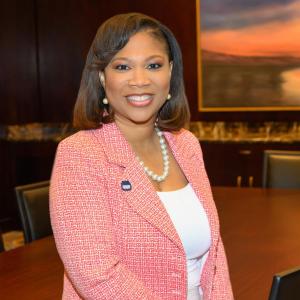NAREB’s 2023 State of Housing In Black America Report Finds Shortage of Housing Inventory Limits Black Homeownership
SHIBA says factors restricting Black homeownership are lower wealth and median incomes, an unfavorable housing market, housing shortages, and institutional bias
BIRMINGHAM , ALABAMA, UNITED STATES, November 9, 2023 /EINPresswire.com/ -- DOWNLOAD THE 2023 SHIBA REPORT HERE
Major barriers impede homeownership among African Americans, despite record-low Black unemployment and a higher labor force participation rate than Whites, according to the 2023 State of Housing in Black America (SHIBA) report released today by the National Association of Real Estate Brokers (NAREB).
The SHIBA report, released today at NAREB’s Black Wealth Summit at Miles College near Birmingham, AL, found that an inadequate supply of new homes is a significant contributor to the growing housing crisis, particularly for potential Black buyers. Housing demand outpaces new home construction by roughly 100,000 units annually, creating the largest housing shortfall in nearly half a century. The lack of housing stock contributes to sustained high prices despite high-interest rates. These are factors negatively impacting Black homeownership.
“Housing inventories must be increased across the country,” said Dr. Courtney Johnson Rose, the NAREB president. “Families can’t buy homes if they aren’t available or if the market is so tight that prices are artificially high. Clearly, there is a connection between the lack of inventory and the inability to increase Black homeownership substantially. It’s time for key components of the housing finance industry, such as Fannie Mae and Freddie Mac, to facilitate new home construction or even rehabilitation of existing homes.”
Citing the most recent information available, including from the 2022 Home Mortgage Disclosure Act, the SHIBA report noted the Black homeownership rate was 45% in 2022, nearly 30% lower than White households, with a wider gap than 50 years ago. SHIBA also determined that the Black-White wealth gap is so expansive that the 400 wealthiest Americans control the same amount of wealth as the 48 million Blacks living in the United States.
“This year’s SHIBA report solidifies the connection between Black wealth and homeownership, details the obstacles that limit Black homeownership, and provides recommendations for creating more homebuying opportunities for Blacks,” said Dr. Rose. She added that significant barriers to increasing Black homeownership exist in communities around the country, including lower wealth and median incomes, unfavorable housing market conditions, and institutional bias within the housing finance system.
Obstacles to Black homeownership date back to the early 20th century, Dr. Rose said, when discriminatory public and private housing policies such as redlining were rampant. These policies systematically excluded Blacks from acquiring loans or purchasing homes in specific neighborhoods, resulting in severe racial disparities in homeownership rates and driving Black communities into economic wastelands.
“Narrowing the Black-White racial gaps in homeownership and wealth will require strong action at the federal level,” said Dr. Rose, acknowledging that under President Biden, the government has taken steps in the right direction. “Federal government policies contributed to these racial gaps, and now the government must invest in fixing them so that the idea of a fair and just America can exist for all our citizens.”
Further, the Black homeownership rate has not increased substantially even though the gap in labor force participation rates for Blacks and Whites is at a historic low, with Blacks now having a higher labor force participation rate than their White counterparts. This positive employment news might suggest an ability for Blacks to have attained major homeownership gains over the past year. However, significant obstacles continued to impede Black homeownership.
Among the findings in the SHIBA report are that:
Black applicants had a 21% mortgage loan denial rate at traditional banks compared to 8% among White applicants. At independent mortgage companies, Black denial rates were slightly lower at 15% compared to 6% for Whites.
Changes to Fannie Mae and Freddie Mac pricing grids and movement toward more accurate and reliable credit scoring models are steps forward. However, major gains in Black homeownership will require additional housing market interventions.
Housing affordability is a challenge for Black homeownership. The 30-year fixed rate mortgage surpassed 7% in November of 2022, compared to a rate of less than half that (2.98%) twelve months earlier. Soaring mortgage interest rates were a response to rapid interest rate increases by the Federal Reserve Board in its efforts to lower inflation.
Affordability fell steeply starting in the second quarter of 2022. By the fourth quarter, only 38% percent of new and existing homes sold were affordable to families with an annual income of $90,000. This placed the median-priced new and existing home far out of reach for many Blacks, whose median household income is $52,860.
Investor home purchases accelerated during the 2020-2021 pandemic. By the first quarter of 2022, investor purchases of single-family homes peaked at 28% of market share. As of the first quarter of 2023, investors accounted for about 27% of single-family home purchases.
Investor home purchases negatively impact the affordability and supply of homes for sale, particularly for lower-income households. Investors outbid typical homebuyers and pay cash for houses that don’t require inspections or appraisals. Many investor-owned single-family homes are transformed into rental housing, removing it from the owner-occupied stock.
A large proportion of home mortgages to Black borrowers continue to be made in census tracts vulnerable to the effects of climate change. As climate-related severe weather increases in the coming decades, Black homeowners and renters in vulnerable areas will be the hardest hit and face billions of dollars of losses.
Declaring an enormous need to increase the affordable housing stock, the report called for reforming the nation’s housing finance system and including components to rehabilitate and produce housing stock. An efficient housing rehabilitation program could save 107,000 homes annually from obsolescence.
It also called for a reconfigured housing finance system to encourage responsible, safe, and sound financial innovation, such as requiring a restructured Fannie Mae and Freddie Mac to form partnerships with the nation’s largest financial institutions to enhance the promising special-purpose credit programs the banks launched to increase Black homeownership.
(For print or broadcast interviews with NAREB President Courtney Johnson Rose, contact Michael Frisby, Mike@frisbyassociates.com/202-625-4328)
Michael K Frisby
Frisby & Associates
+1 202-625-4328
mike@frisbyassociates.com
Legal Disclaimer:
EIN Presswire provides this news content "as is" without warranty of any kind. We do not accept any responsibility or liability for the accuracy, content, images, videos, licenses, completeness, legality, or reliability of the information contained in this article. If you have any complaints or copyright issues related to this article, kindly contact the author above.


